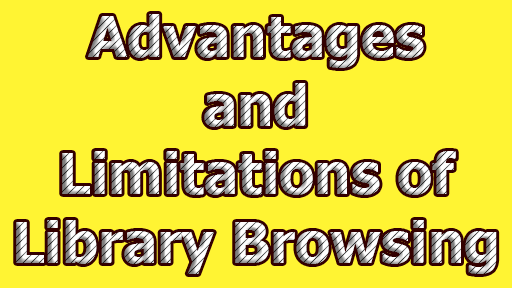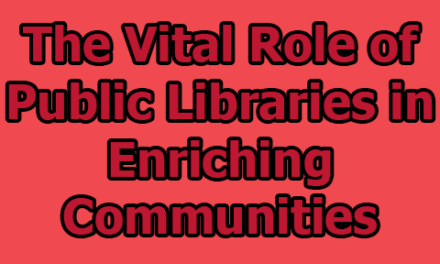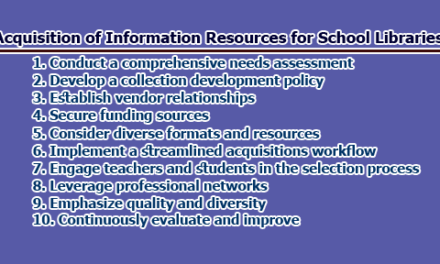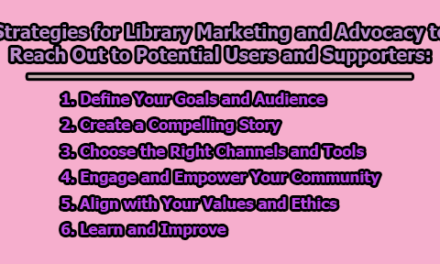Advantages and Limitations of Library Browsing:
Library browsing is the traditional method of discovering and accessing information and resources in a library setting. It involves physically browsing through the shelves and collections to find books, journals, magazines, and other materials of interest. While the digital age has brought about various online catalog systems and digital libraries, library browsing remains a prevalent and valuable way of accessing information. In this article, we will explore the advantages and limitations of library browsing to understand its role in the modern information landscape.
Advantages of Library Browsing:
1. Serendipitous Discovery: Library browsing allows users to stumble upon books and resources they were not actively looking for. The act of scanning shelves can lead to unexpected encounters with valuable information and diverse perspectives that might have been missed in targeted online searches.
2. Physical Experience: Browsing through a physical library provides a unique sensory experience. The feel and smell of books, the sound of pages turning, and the visual richness of the library environment create a more profound connection with the knowledge-seeking process.
3. Exploration and Curiosity: The freedom to explore different sections and topics fosters curiosity among users. By meandering through diverse subjects, users can make interdisciplinary connections and gain a more comprehensive understanding of various subjects.
4. Quick Access: For those with immediate information needs, library browsing offers a swift way to access materials. Instead of waiting for a digital resource to load or dealing with internet connectivity issues, users can go directly to the relevant section and retrieve the required material promptly.
5. Unique Collections: Many libraries house rare and valuable collections that are not digitized or available online. Browsing through these special collections allows researchers, scholars, and enthusiasts to access exclusive resources that contribute to the richness of their work.
6. Reduced Dependence on Technology: Library browsing provides an alternative to relying solely on digital technology for information retrieval. This becomes especially important during technical outages or when access to online resources is limited.
7. Enhanced Focus: In a digital environment, users often face distractions such as pop-up ads, notifications, or unrelated search results. In contrast, browsing in a physical library minimizes these distractions, allowing users to focus more intently on their research.
8. Discovering Hidden Gems: Some older or lesser-known materials might not be prominently featured in online searches due to algorithms favoring popular content. However, such valuable resources can be found through library browsing, enriching the user’s research.
9. Improved Serendipity for Children: Browsing in a physical library can ignite a love for reading in children. As they peruse the shelves, they may stumble upon captivating books they might not have encountered through algorithm-based online recommendations.
10. Personal Interaction: Library browsing offers the opportunity for personal interactions with librarians and fellow patrons. Librarians can provide guidance and suggestions based on individual interests, while fellow patrons can share insights and create a sense of community within the library space.
Limitations of Library Browsing:
1. Limited Accessibility: Library browsing requires users to visit the physical library, which can be a challenge for those with mobility issues or residing far from the library’s location. Online resources, on the other hand, offer greater accessibility regardless of geographic location.
2. Time-Consuming: Browsing through shelves can be time-consuming, especially when users are searching for specific information. Digital search engines, with their ability to deliver instant results, can be more efficient in this regard.
3. Organizational Challenges: Inconsistent or inadequate organization systems can hinder the browsing experience. Users may struggle to find relevant resources if materials are not properly categorized, labeled, or shelved.
4. Space Limitations: Libraries have finite shelf space, meaning that not all materials can be displayed simultaneously. Users may miss out on valuable resources that are not currently available on the shelves.
5. Lack of Search Features: Unlike digital catalogs, physical browsing lacks search functionalities like keyword searches and filters. This limitation can make it challenging to narrow down broad topics quickly.
6. Incomplete Information: Users might miss out on valuable resources if they overlook relevant sections or if the library’s holdings are not adequately updated in the catalog.
7. Limited Availability of Multiple Copies: In popular libraries, there may be a high demand for specific materials, leading to limited availability and potential disappointment for users seeking multiple copies of a resource.
8. Environmental Impact: Library browsing involves the physical production and maintenance of print materials, which can have a higher environmental footprint compared to digital resources.
9. Language Barriers: Libraries with collections in multiple languages may present a challenge for users who do not understand the language of the materials, limiting their access to relevant resources.
10. Inflexible Operating Hours: Physical libraries have set operating hours, which may not align with users’ schedules. This limitation can restrict their ability to access information when they need it the most, unlike online resources that are available 24/7.
In conclusion, library browsing offers several distinct advantages, such as the joy of serendipitous discovery, the physical experience of interacting with books, and the opportunity for exploration and interdisciplinary learning. It provides quick access to materials and access to unique collections not available online. However, library browsing also comes with limitations, including limited accessibility, time consumption, organizational challenges, space limitations, and the absence of search features. Despite its drawbacks, library browsing continues to be a valuable method for discovering information and remains an essential component of the library experience. With the integration of digital technologies and traditional browsing methods, libraries can strive to offer a more comprehensive and inclusive information access experience for their patrons.
FAQs:
What is library browsing?
Library browsing refers to the act of physically exploring a library’s shelves and collections to find books, journals, and other resources of interest. It involves visually scanning the materials and allows users to serendipitously discover valuable information.
How does library browsing compare to online research?
Library browsing offers a physical and serendipitous experience, encouraging exploration and a deeper connection with materials. Online research provides instant results, broader accessibility, and various search features. Both methods have their merits and are often used in combination for comprehensive research.
Can library browsing be done online?
While the traditional concept of library browsing involves physical presence, some libraries offer virtual browsing experiences through online catalog interfaces. Users can visually explore virtual shelves and collections, mimicking the feel of in-person browsing.
Is library browsing still relevant in the digital age?
Yes, library browsing remains relevant as it offers unique benefits, such as serendipitous discovery and a physical experience with materials. In the digital age, libraries often integrate digital catalogs and online resources to complement traditional browsing methods.
How can libraries improve the browsing experience for users?
Libraries can enhance the browsing experience by maintaining well-organized collections, updating catalog information regularly, and offering virtual browsing options. Providing clear signage and guidance, along with engaging displays, can also improve the overall browsing experience.
What are some alternative methods to library browsing for information retrieval?
In addition to library browsing, users can access information through online databases, digital libraries, search engines, and academic repositories. Online resources offer the advantage of convenience and broader accessibility.
Can library browsing be adapted for individuals with disabilities?
Libraries can make browsing more accessible for individuals with disabilities by ensuring facilities are wheelchair-friendly and offering digital accessibility options. Providing assistance from trained staff can further support users with specific needs.
How can researchers make the most of library browsing?
Researchers can maximize the benefits of library browsing by having a general idea of their research topic and then exploring related sections. They should also engage with librarians, who can offer valuable guidance and recommendations based on their expertise.
References:
- Verhoeven, J. C., & Lippincott, J. K. (2016). The future of library spaces: Physical, digital, and hybrid contexts. Routledge.
- Courtois, C., & Cramer, J. (2007). Learning in the Information Age: Effective practices for school library media programs. Linworth Publishing, Incorporated.
- Carbo, T. (2007). Organizing the library media center: A guide for library media specialists. Linworth Publishing, Incorporated.
- Cassidy, K., & Grotevant, K. (2014). The 21st-century library media center: A vital force in teaching, learning, and the community. Rowman & Littlefield.
- Pham, H. (2006). The challenges of collection management in the digital age: A case study of the University of California, Berkeley Library. Library Collections, Acquisitions, and Technical Services, 30(3-4), 188-196.
- Pinto, M., Sales, D., & Marujo, N. (2015). Usability evaluation of library interfaces: A case study. Library Hi Tech, 33(1), 78-92.
- Gorman, M. (2003). Our enduring values: Librarianship in the 21st century. American Library Association.
- Chowdhury, G. G. (2004). Introduction to modern information retrieval. Facet publishing.

Library Lecturer at Nurul Amin Degree College










